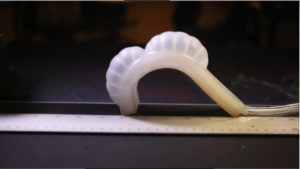Blockbuster films and video games are now doing more than just entertaining. Thanks to collaborators from the University of California Los Angeles (UCLA) and Carnegie Mellon University, the sophisticated technology behind the screen of movies and games are being used to help control robots.
This team adapted the tech typically used for high-end computer graphics to simulate the movements of limbed robots for the first time. These findings were recently published Nature Communications.
“Soft robots are made of flexible material, which makes them intrinsically resilient against damage and potentially much safer in interaction with humans,” explained said study author Khalid Jawed, an assistant professor of mechanical and aerospace engineering at UCLA. “Prior to this study, predicting the motion of these robots has been challenging because they change shape during operation.”
Moviemakers use an algorithm called Discrete Elastic Rods (DER) to animate free-flowing objects. DER can predict hundreds of movements within a second. The collaborators worked to design a physics engine with DER that could simulate movements of bio-inspired robots in challenging conditions — such as on the surface of Mars or underwater.
Similarly, another algorithm-based technology, called Finite Elemental Method (FEM), is capable of simulating the movements of rigid and solid robots. However, it lacks the ability to simulate complex soft and natural movements. It consumes high power and requires a lot of time. The existing computer simulation tools can only model hard and inflexible robots easily. But soft and squishy robots need special tools that are yet to come.
The team has been working on this project for more than three years. It is one of the first to demonstrate how soft robots can be simulated flawlessly with the computer graphics software used to model hair and fabrics in blockbuster animal movies and films.
Jawed recently ran the simulations in his UCLA-based research lab while one of his teammate’s performed the physical experiments that certified the simulation results.
“Experimental advances in soft-robotics have been outpacing theory for several years,” said Samuel Stanton, a program manager with the Army Research Office. The project was funded by the Army Research Office. “This effort is a significant step in our ability to predict and design for dynamics and control in highly deformable robots operating in confined spaces with complex contacts and constantly changing environments.”
Filed Under: News



Questions related to this article?
👉Ask and discuss on EDAboard.com and Electro-Tech-Online.com forums.
Tell Us What You Think!!
You must be logged in to post a comment.